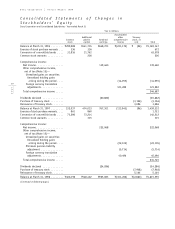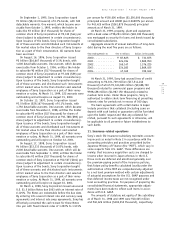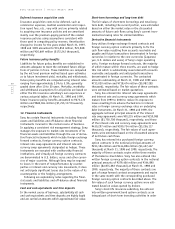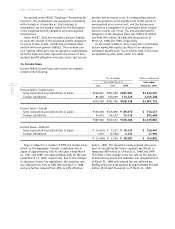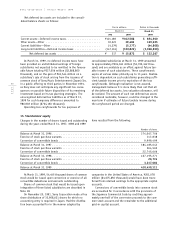Sony 1999 Annual Report Download - page 62
Download and view the complete annual report
Please find page 62 of the 1999 Sony annual report below. You can navigate through the pages in the report by either clicking on the pages listed below, or by using the keyword search tool below to find specific information within the annual report.
60
page
Sony Corporation Annual Report 1999
Deferred insurance acquisition costs
Insurance acquisition costs to be deferred, such as
commission expenses, medical examination and inspec-
tion report fees, etc., vary with and are primarily related
to acquiring new insurance policies and are amortized
mainly over the premium-paying period of the related
insurance policies using assumptions consistent with
those used in computing policy reserves. Amortization
charged to income for the years ended March 31, 1997,
1998 and 1999 amounted to ¥15,855 million, ¥21,838
million and ¥20,669 million ($172,242 thousand),
respectively.
Future insurance policy benefits
Liabilities for future policy benefits are established in
amounts adequate to meet the estimated future obliga-
tions of policies in force. These liabilities are computed
by the net level premium method based upon estimates
as to future investment yield, mortality and withdrawals.
Future policy benefits are computed using interest rates
ranging from approximately 2.5% to 5.5%, generally
graded down after 10 to 20 years. Mortality, morbidity
and withdrawal assumptions for all policies are based on
either the life insurance subsidiary’s own experience or
various actuarial tables. At March 31, 1998 and 1999,
future insurance policy benefits amounted to ¥673,473
million and ¥865,814 million ($7,215,117 thousand),
respectively.
12. Financial instruments
Sony has certain financial instruments including financial
assets and liabilities and off-balance-sheet financial
instruments incurred in the normal course of business.
In applying a consistent risk management strategy, Sony
manages the exposure to market rate movements of its
financial assets and liabilities through the use of deriva-
tive financial instruments which include foreign exchange
forward contracts, foreign currency option contracts,
interest rate swap agreements and interest rate and
currency swap agreements designated as hedges. These
instruments are executed with creditworthy financial
institutions, and virtually all foreign currency contracts
are denominated in U.S. dollars, euros and other curren-
cies of major countries. Although Sony may be exposed
to losses in the event of nonperformance by counter-
parties or interest and currency rate movements, it does
not anticipate significant losses due to the nature of its
counterparties or the hedging arrangements.
Following are explanatory notes regarding the finan-
cial assets and liabilities and off-balance-sheet financial
instruments.
Cash and cash equivalents and time deposits
In the normal course of business, substantially all cash
and cash equivalents and time deposits are highly liquid
and are carried at amounts which approximate fair value.
Short-term borrowings and long-term debt
The fair values of short-term borrowings and total long-
term debt, including the current portion, were estimated
based on either the market value or the discounted
amounts of future cash flows using Sony’s current incre-
mental borrowing rates for similar liabilities.
Derivative financial instruments
Sony utilizes foreign exchange forward contracts and
foreign currency option contracts primarily to fix the
cash flow value resulting from accounts receivable and
payable and future transactions denominated in foreign
currencies in relation to the core currencies (Japanese
yen, U.S. dollars and euros) of Sony’s major operating
units. Foreign exchange forward contracts, the majority
of which mature within three months, are used to hedge
this risk which is substantially associated with accounts
receivable and payable and anticipated transactions
denominated in foreign currencies. The contracted
amounts outstanding at March 31, 1998 and 1999 were
¥733,020 million and ¥718,474 million ($5,987,283
thousand), respectively. The fair values of these contracts
were estimated based on market quotations.
Sony has entered into interest rate swap agreements
and interest rate and currency swap agreements which
mature from 1999 to 2006 to reduce its exposure to
losses resulting from adverse fluctuations in interest
rates or foreign currency exchange rates on underlying
debt instruments. At March 31, 1998 and 1999, the
aggregate notional principal amounts of the interest
rate swap agreements were ¥91,235 million and ¥210,085
million ($1,750,708 thousand), respectively, and those
of the interest rate and currency swap agreements were
¥430,297 million and ¥390,734 million ($3,256,117
thousand), respectively. The fair values of such agree-
ments were estimated based on the discounted amounts
of net future cash flows.
Sony has entered into purchased foreign currency
option contracts in the notional principal amounts of
¥233,184 million and ¥414,896 million ($3,457,467
thousand) at March 31, 1998 and 1999, respectively. The
majority of these contracts expire within three months
of the balance sheet dates. Sony has also entered into
written foreign currency option contracts in the notional
principal amounts of ¥279,406 million and ¥344,890
million ($2,874,083 thousand) at March 31, 1998 and
1999, respectively. The majority of these contracts are
part of range forward contract arrangements and expire
in the same month with the corresponding purchased
foreign currency option contracts described above. The
fair values of such foreign currency options were esti-
mated based on values quoted by brokers.
Sony’s stock life insurance subsidiary has entered
into written government bond option contracts as an
integral part of short-term investing activities in order


